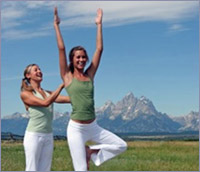 All forms of Yoga have the same objective: to stimulate and raise the kundalini energy through the spine. Kundalini energy, which we all have, is located in the base of the spine. Through the practice of yoga, the techniques of breathing, and meditation, this energy is stimulated and begins to rise up the spine.
All forms of Yoga have the same objective: to stimulate and raise the kundalini energy through the spine. Kundalini energy, which we all have, is located in the base of the spine. Through the practice of yoga, the techniques of breathing, and meditation, this energy is stimulated and begins to rise up the spine.
Aligned in the spine are the chakras, or energy centers. Each chakra has different qualities (see Chakras), and each one is necessary and important. When the kundalini energy rises and begins to cross the different chakras, you will experience higher states of being.
Some forms of yoga accelerate this process more than others, but it also depends on the specific person, their attitude, their flexibility and so on.
Kundalini Yoga
Kundalini yoga is considered to be one of the fastest approaches for raising the kundalini energy. This is in part because all of the classes utilize pranayama (breathing techniques), asanas (positions), meditation and relaxation. This style of yoga is appropriate for all levels.
Kundalini yoga places a great deal of importance on healing. Many sets of yoga are dedicated to the different areas of the body such as the back, heart, liver, kidneys, etc. This style of yoga also influences our emotional side as it eases stress, opens the center of the heart, balances our emotions, combats insomnia, and so forth.
Kundalini Yoga is very musical and involves singing and the recitation of mantras. Music is used during the whole class.
White Tantric Yoga
The practice of White Tantric yoga for one week twice a year during the winter and summer solstices is said to be as powerful as seven years of continuous practice of yoga. For more information, visit http://www.whitetantricyoga.com or http://www.3ho.org
Ashtanga Yoga
Ashtanga yoga is a more energetic form of yoga. People who have played sports and are flexible and strong will enjoy this type of yoga quite a bit. With this practice, one acquires great strength and flexibility.
My personal experience with Ashtanga Yoga is that at the beginning of the class the thoughts are many and constant, but as I start moving through the asanas the thoughts slowly start to decrease, and at the end of the class they are minimized or gone.
Meditation is not practiced at the end of an Ashtanga yoga class. Patabbhi Jois says, “Don’t think, just practice”.
Power Yoga
Power yoga is very similar in practice to Ashtanga yoga. The main difference is that power yoga does not continue the traditional method taught by Pattabhi Jois. Instead, the order of the poses are varied and other poses are added, creating a style that might be described as a modern version of Ashtanga Yoga.
Bikram Yoga
Also known as “Hot Yoga”, Bikram yoga is practiced in a room that is heated to approximately 100 degrees Fahrenheit. Heating the room allows the muscles to relax and prevents muscle injury. In addition, practicing yoga at this temperature increases physical endurance.
The famous sun salutation is not practiced at the beginning of the class. This may be because the heat warms and opens the body.
There are two things that always caught my attention with Bikram classes. First was the incredible ability of the body to adapt to the high temperatures within two weeks of practice. Second was the fact that the class was almost entirely comprised of men, the reason for which I never knew.
Hatha Yoga
Hatha yoga is a moderate form of yoga. It is appropriate for all levels. Almost all of the types of Yoga are derived from Hatha Yoga. The poses are all the same. The differences are in how long and how often the poses are practiced, whether or not there are rests between poses, if the room is heated, and so on.
Iyengar Yoga
Iyengar yoga is another form of yoga that is appropriate for all levels. This type of yoga is known for its use of props, such as blocks, which help you to perform the poses. It is a very precise form of yoga which specifically focuses on attaining an ideal alignment of the body. Iyengar continues the eight limbs of yoga as defined by Patanjali (/Ashtanga/The-Eight-Limbs-of-Yoga.html)
Concentration and meditation are a part of Iyengar practice. There are also healing programs designed to address different areas of the body such as the lower back.
Vinyasa Yoga
Vinyasa yoga is an energetic yoga practice. Breathing plays an important role, and the movement from one pose to another is synchronized with the breathing. A typical class includes “sun salutation” followed by poses of a medium/intense level. This is a very energetic and dynamic yoga practice!
Kripalu Yoga
Kripalu yoga is a moderate practice of yoga appropriate for all levels. The classic poses of Hatha are used along with breathing exercises, or pranayama, to enter a “meditation in movement” state.
Jivamukti Yoga
Jivamukti yoga is an intensely physical form of yoga. Created by David Life & Sharon Gannon, it combines Ashtanga yoga by Pattabhi Jois with Vinyasa yoga. During practice, writings are studied and mantras are recited and sung. It is a very musical form of yoga.
I hope this information helps you! The opinions cited here are personal, based on my own experiences and opinions, in the hopes of providing the novice with a guide. You will no doubt find other opinions from other people. – Indra K
